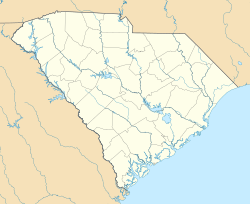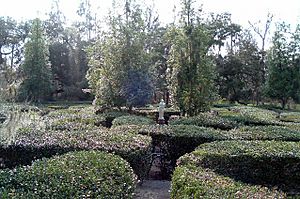Magnolia Plantation and Gardens (Charleston, South Carolina) facts for kids
Quick facts for kids |
|
|
Magnolia Plantation and Gardens
|
|

Plantation home at Magnolia Plantation
|
|
| Nearest city | Charleston, South Carolina |
|---|---|
| Area | 390 acres (160 ha) |
| Built | 1850 |
| NRHP reference No. | 72001198 |
| Added to NRHP | December 11, 1972 |
Magnolia Plantation and Gardens is a very old and beautiful place in South Carolina. It has a historic house and amazing gardens. You can find it on the Ashley River, close to Charleston. This plantation is one of the oldest in the southern United States. It is also listed on the National Register of Historic Places, which means it's an important historical site.
The plantation started way back in 1679. That's when Thomas and Ann Drayton built a house and a small garden here. The Drayton family has owned Magnolia Plantation for over 300 years, through 15 generations! Sadly, the Draytons brought enslaved people from Barbados in the 1670s to work on the plantation. These workers were forced to build and maintain the property.
Magnolia was first a rice plantation. Enslaved people from rice-growing parts of Africa built special dams and dikes. These structures helped bring water from the river to grow rice. Over time, these enslaved people created a unique culture and language called Gullah. This culture is still strong today in the Lowcountry and Sea Islands.
Contents
Discovering Magnolia's Rich History
Magnolia Plantation has a long and interesting past. It changed a lot over the years, especially its famous gardens.
How the Gardens Grew Famous
In the 1840s, Reverend John Grimké Drayton took over the property. He loved gardening and made the gardens even more beautiful. He was one of the first people to plant Camellia japonica outdoors in the 1820s. He also brought the first azaleas to America.
Under his care, the gardens became famous for their azaleas and huge live oak trees. Even famous photographer Mathew Brady took pictures of them. John James Audubon, a well-known bird artist, also visited. Today, a part of the garden, the Audubon Swamp Garden, is named after him.
Changes After the Civil War
During the American Civil War, the original plantation house was burned down. Union soldiers likely caused the fire. After the war, John Grimké Drayton had to sell most of the land. He kept about 390 acres.
Today, 25 acres are for the gardens. Another 16 acres are for the wide lawn around the live oak trees. About 150 acres are a marsh and a place for water birds. Since 1941, a large part of the land has been used to grow plants for sale. This helps pay for the garden's upkeep.
Famous Visitors Over Time
Many famous people have visited Magnolia Plantation. In the 20th century, guests included musician George Gershwin, car maker Henry Ford, First Lady Eleanor Roosevelt, actor Orson Welles, and singer Reba McEntire. The artist William Posey Silva painted the gardens many times. Some of his paintings are still in the main house.
Magnolia Plantation is also recognized for sharing the history of slavery on its website. This helps visitors understand the full story of the plantation.
Exploring Magnolia Plantation Today
Today, Magnolia Plantation is a museum and a popular place for tourists. You can visit the house and explore the amazing gardens.
The Plantation House and Its Story
The house you see today was rebuilt after the Civil War. The oldest part of the house was moved here from another location after the war. The wide porch and large columns were added later.
Enslaved Africans and African Americans lived and worked on plantations like Magnolia. They often lived in large groups and developed their own unique culture. This included the Gullah language, which mixes West African languages with English. They also had special foods, like rice and seafood, and crafts, such as baskets made from sea grass.
Learning About African American History
There are five cabins on the property. Four of them were built during the time of slavery. One was built around 1900. After slavery ended, freed people lived in these cabins. To show how life changed, the cabins are set up to look like different time periods. Some show life in 1850, and others show life after the Civil War.
The plantation offers a program called From Slavery to Freedom. It teaches visitors about the lives of African Americans at Magnolia. Archeologists are also studying the site to learn more about the skilled gardeners and craftspeople who lived and worked here.
Nature and Fun Activities
Magnolia Plantation also has many ways to enjoy nature. You can take a nature train ride or a marsh boat tour. There's also a wildlife area. A petting zoo lets you meet friendly animals. Many of these attractions were added starting in 1975.
Amazing Garden Features
The gardens are filled with beautiful azaleas and many other plants. Here are some special parts of the gardens:
- Barbados Tropical Garden - An indoor garden with plants from tropical places.
- Biblical Garden - Plants mentioned in the Bible, divided into Old Testament and New Testament sections.
- Camellia Collection - Some Camellia japonica plants here are from the 1820s. There are nearly 900 different kinds of camellias!
- Cattail Wildlife Refuge - A large area for wildlife, with a tower to watch birds.
- Cypress Lake - Features Bald cypress trees, some up to 100 years old, along the river and wetlands.
- Flowerdale - This is one of the oldest parts of the garden, started in 1680. It has formal beds of flowers surrounded by boxwood hedges.
- Long Bridge - Built in the 1840s, it's one of seven bridges on the grounds.
- Maze - A fun maze like the famous one in England. It's made of 500 Camellia sasanqua plants and holly.
- Nature Center and Zoo - Here you can see farm animals, rescued native animals, and exotic birds like peacocks.
- Swamp Garden - This area shows off local plants and the rich ecosystem of the swamp.
More to Explore
- John Grimké Drayton
- McLeod Plantation
- Middleton Place
- List of botanical gardens in the United States
- Old St. Andrew's Parish Church
- St. Andrew's Mission Church (Charleston, South Carolina)
See also
 In Spanish: Jardines y Plantación Magnolia para niños
In Spanish: Jardines y Plantación Magnolia para niños









